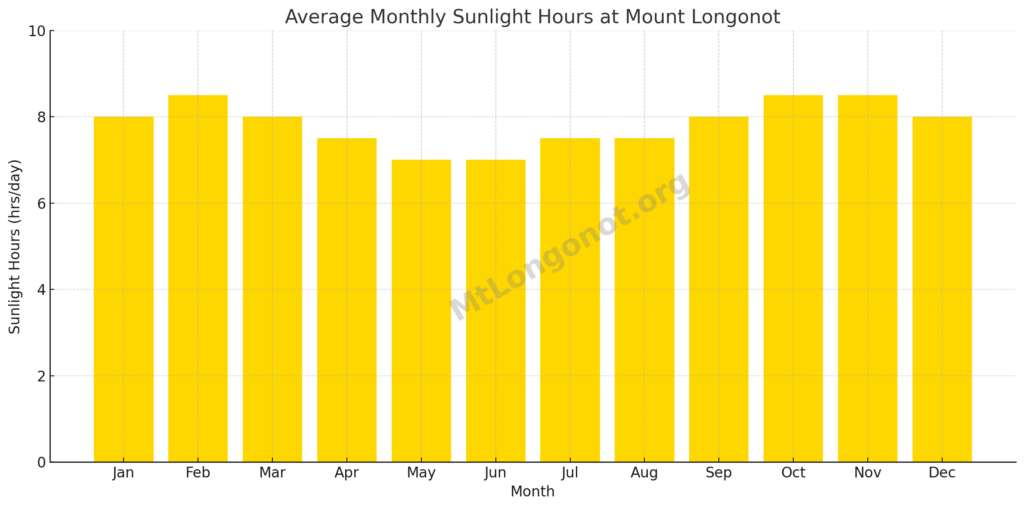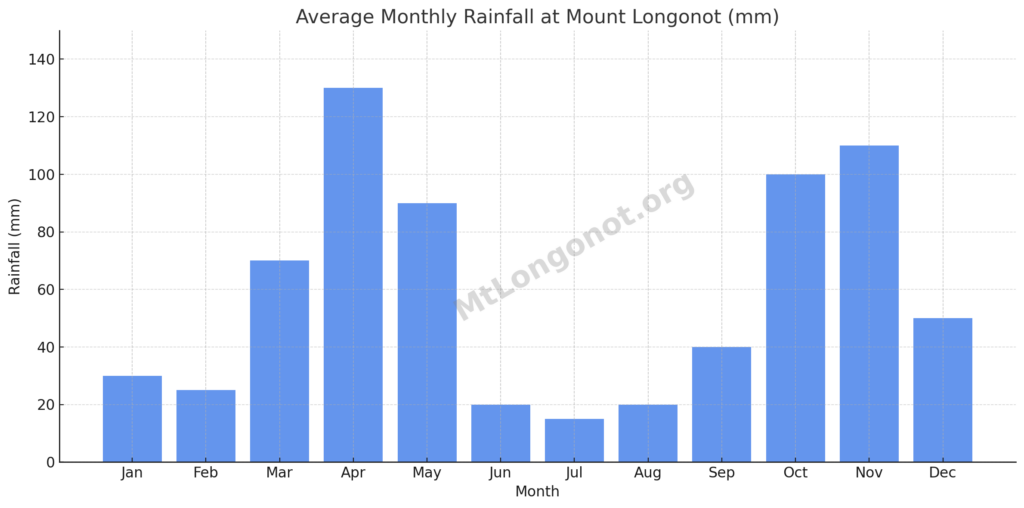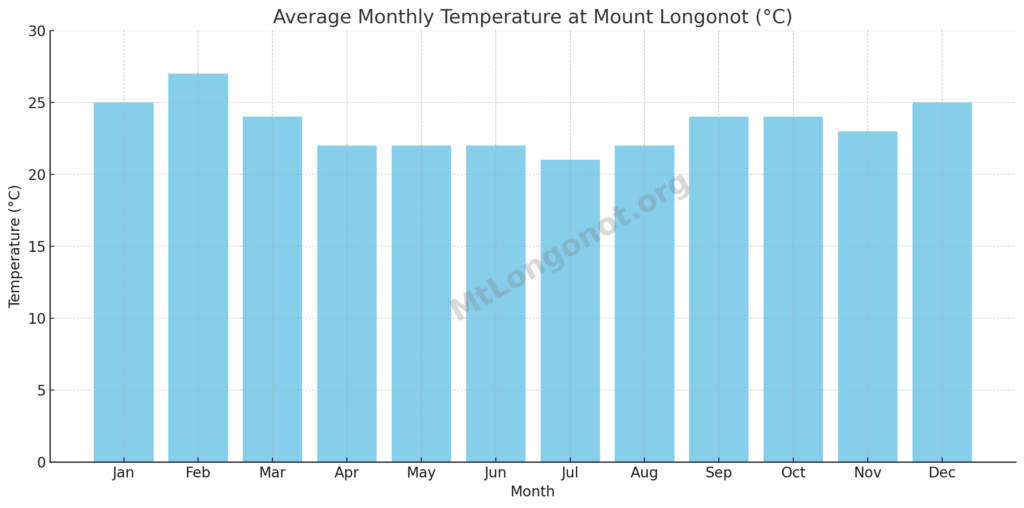Mount Longonot’s dramatic rise from the Rift Valley floor creates a microclimate that’s often cooler and windier than the surrounding Naivasha plains. Though it sits near the equator, Longonot’s elevation of 2,776 meters (9,108 ft) means hikers can expect quick weather changes, intense sun, and sudden chill — sometimes all in one day.
Understanding the climate here is essential for a safe and comfortable hike. This guide breaks down the weather patterns by season, time of day, and offers practical packing tips.
🗓️ Mount Longonot Climate Overview
| Feature | Detail |
|---|---|
| Elevation | Base ~2,150 m / Summit ~2,776 m |
| Climate Type | Semi-arid with montane influences |
| Daytime Temps | 18°C – 26°C (64°F – 79°F) |
| Night Temps | Can drop to 8°C – 12°C (46°F – 53°F) |
| Sunrise | ~6:30 AM year-round |
| Sunset | ~6:30 PM year-round |
| UV Exposure | High, due to elevation and equatorial sun |
| Rainy Seasons | March–May & October–November |
| Dry Seasons | January–February & June–September |

🌦️ Weather by Season: What to Expect
☀️ Dry Season (Best for Hiking)
Months: January – February & June – September
Conditions:
- Clear skies, warm days, low humidity
- Cool, breezy mornings
- Minimal rain and dustier trails
What to Wear:
- Breathable, moisture-wicking shirt
- Lightweight hiking pants or shorts
- Hat and sunglasses for sun protection
- Light fleece or windbreaker (especially for early starts)
🎯 Best time for crater rim photography, summit hikes, and long trail runs.
🌧️ Rainy Season (Be Cautious)
Months: March – May & October – November
Conditions:
- Afternoon rain showers common
- Slippery, muddy trails and loose volcanic ash
- Fog or mist can reduce visibility
- Cooler daytime temps
What to Wear:
- Quick-dry base layers
- Waterproof or windproof jacket
- Sturdy boots with good traction
- Gaiters (optional, but great for muddy terrain)
- Waterproof bag cover or dry bag for valuables
🧭 Plan to hike in the morning — storms often roll in after 2 PM.

🕒 Daily Temperature Shifts
| Time of Day | What You’ll Feel | What to Wear |
|---|---|---|
| 6–8 AM | Chilly and breezy (~10–14°C) | Long sleeves, fleece, light gloves (optional) |
| 9–12 PM | Warming up (~18–22°C) | T-shirt or breathable layer |
| 12–3 PM | Peak heat (~23–26°C) & intense sun | Sunhat, sunglasses, sunscreen, drink water |
| 3–6 PM | Cooling again (~16–20°C) | Layer back up, especially at elevation |
🎒 Bring layers you can shed and re-add easily. Longonot’s weather can swing fast, especially near the crater rim.

📆 Mount Longonot Weather: Month-by-Month Travel Guide
Despite its location near the equator, Mount Longonot’s elevation (2,776m) creates cooler and more unpredictable conditions than the surrounding lowlands. This guide will help you navigate weather patterns, dress appropriately, and choose the best time for your hike.
🌤️ January
- Weather: Dry, sunny, low humidity
- Temperature: 11°C (night) – 25°C (day)
- Rainfall: Minimal
- Trail Conditions: Dry and dusty, great visibility
- What to Wear: T-shirt, light hiking pants, sun hat, sunglasses, fleece for early mornings
✅ Excellent month for hiking, photography, and crater rim views.
🌤️ February
- Weather: Hottest dry month
- Temperature: 13°C – 27°C
- Rainfall: Very low
- Trail Conditions: Warm, dry, dusty
- What to Wear: Breathable layers, light sunproof clothing, hydration pack
🔥 Start early to avoid heat; UV exposure is intense.
🌦️ March
- Weather: Transition to rainy season
- Temperature: 12°C – 24°C
- Rainfall: Starts increasing, especially later in the month
- Trail Conditions: Dry in the morning, possible showers in the afternoon
- What to Wear: Waterproof jacket, light long-sleeve, boots with good grip
⚠️ Plan early hikes; carry a rain cover for your bag.
🌧️ April
- Weather: Wettest month of the year
- Temperature: 11°C – 22°C
- Rainfall: Heavy and consistent
- Trail Conditions: Muddy, slippery, foggy crater
- What to Wear: Waterproof jacket, quick-dry pants, gaiters, warm layers
🚫 Hiking is possible but challenging — consider rescheduling if conditions are severe.
🌧️ May
- Weather: End of long rains
- Temperature: 10°C – 22°C
- Rainfall: Tapering off, still wet
- Trail Conditions: Improving, but still soft in parts
- What to Wear: Same as April; waterproof boots and an extra dry shirt
☁️ Expect misty mornings, perfect for atmospheric photography.
🌤️ June
- Weather: Start of cool dry season
- Temperature: 8°C – 22°C
- Rainfall: Low
- Trail Conditions: Firming up, cooler and breezy
- What to Wear: Fleece jacket, base layer, sun protection
🌬️ Mornings can be cold and windy, especially at the rim.
☀️ July
- Weather: Coolest and driest month
- Temperature: 7°C – 21°C
- Rainfall: None or very light
- Trail Conditions: Excellent
- What to Wear: Long-sleeve shirt, windbreaker, gloves (optional), warm layer
🧊 Best month for full rim hikes and trail running.
☀️ August
- Weather: Cool, dry, with clearer skies toward end
- Temperature: 8°C – 22°C
- Rainfall: Low
- Trail Conditions: Great for hiking and photos
- What to Wear: Layered clothing, hat, sunscreen
🌄 Sunrise and sunset views are particularly stunning.
🌤️ September
- Weather: Warming up, still dry
- Temperature: 10°C – 24°C
- Rainfall: Light toward end of month
- Trail Conditions: Good, dry and stable
- What to Wear: Short-sleeve top, hiking pants, light fleece for mornings
🎯 Ideal time for full-day hikes and pairing Longonot with Lake Naivasha trips.
🌦️ October
- Weather: Start of short rains
- Temperature: 12°C – 24°C
- Rainfall: Showers increase mid-month
- Trail Conditions: Dry early month, then variable
- What to Wear: Waterproof layer, good boots, cap for sun and rain
⏱️ Watch weather forecasts closely and hike early in the day.
🌧️ November
- Weather: Short rains peak
- Temperature: 12°C – 23°C
- Rainfall: Frequent but shorter than April
- Trail Conditions: Slick slopes, some washout spots
- What to Wear: Rain gear, grippy boots, change of clothes post-hike
🦓 Wildlife sightings increase as animals come to graze near the base.
🌤️ December
- Weather: Dry season returns late in the month
- Temperature: 12°C – 25°C
- Rainfall: Declines after mid-December
- Trail Conditions: Transitioning back to dry
- What to Wear: Light jacket, quick-dry shirt, sun hat
🎄 Great time for holiday hikes, but expect more visitors around Christmas.
🌬️ Winds, UV & Altitude Considerations
- Rim winds can be strong — tie down your hat or wear one with a chin strap
- UV exposure is high year-round — even on cloudy days
- Altitude may cause slight breathlessness, especially near the summit — pace yourself
🧴 Don’t forget:
- SPF 30+ sunscreen
- Lip balm with SPF
- Hydration: 2–3L of water per person minimum
🎒 Essential Packing List by Weather
For All Seasons:
- Hiking boots with ankle support
- Backpack (20–30L)
- 2–3L water (hydration bladder or bottles)
- Snacks / light lunch
- Fully charged phone or power bank
- Basic first aid kit
- Trash bag (pack out what you pack in)
Rainy Season Add-ons:
- Rain jacket
- Dry bag / waterproof phone pouch
- Change of clothes in car or base
🧭 Local Weather Resources
Before your trip, check:
- Naivasha weather forecast (Mount Longonot is slightly cooler due to elevation)
- KWS updates at the park gate or online for trail conditions
- Windy or AccuWeather apps for real-time radar and rainfall alerts
✅ Final Tips: Dress Smart, Hike Safer
- 🎽 Layering is key — start warm, strip down when hiking, bundle up at the rim
- 🌡️ Expect cooler temps at the summit, especially if clouds roll in
- ☀️ Hydrate and protect your skin from sun and wind
- 🧢 Wear a wide-brimmed hat or buff — the sun hits hard by mid-morning
- 🚿 No showers or water taps in the park — freshen up in Naivasha post-hike
